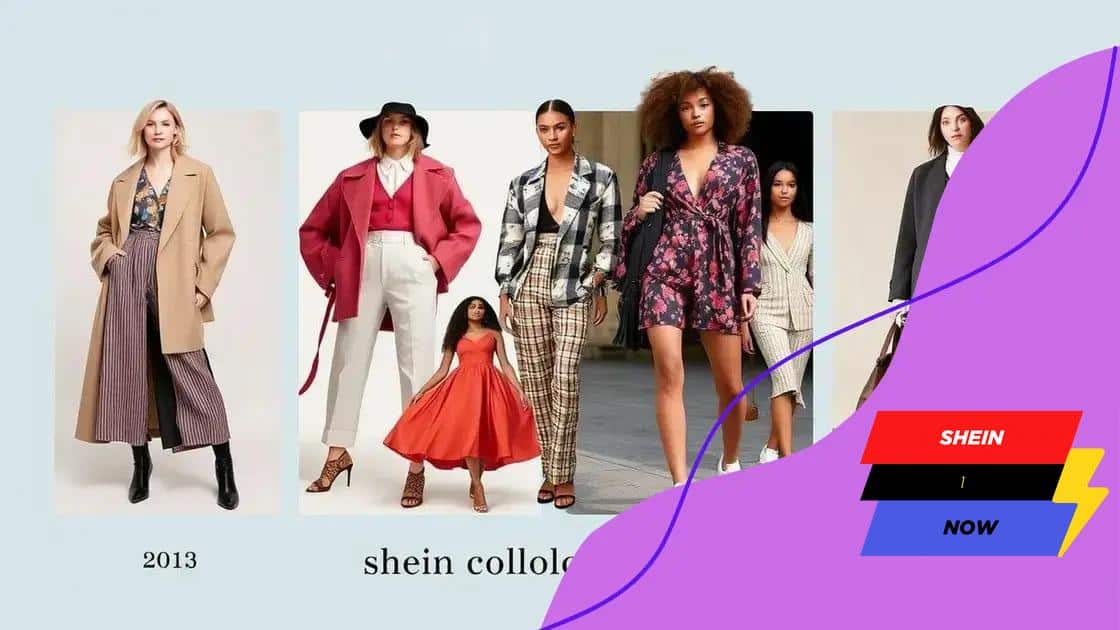Fashion history lessons through Shein’s collections

Fast fashion significantly shapes consumer behavior by promoting impulsive buying and altering perceptions of value, while raising important concerns regarding sustainability and ethical practices within the fashion industry.
Fashion history lessons through Shein’s collections can unveil fascinating insights about style evolution. Have you ever wondered how past trends influence today’s fashion choices? This exploration offers a fresh perspective on what we wear now.
The evolution of fashion trends
The evolution of fashion trends is a captivating journey through time. Each era has its own unique style and characteristics that reflect the culture and values of that period. Understanding this evolution helps us appreciate today’s fashion choices.
Key Factors Influencing Fashion Trends
Several factors play a significant role in shaping fashion trends. Let’s explore some of these influences:
- Cultural movements
- Technological advancements
- Celebrity endorsements
- Economic changes
Cultural movements often pave the way for new trends. For instance, the 1960s saw a huge shift toward more progressive styles, influenced by the counterculture movement. This was a time when people started valuing individuality over conformity.
Technological advancements, such as the introduction of synthetic fabrics, also made waves in the fashion industry. Fabrics like polyester and nylon changed how clothes were made and worn, offering more options for consumers.
How Social Media Shapes Trends
Today, platforms like Instagram and TikTok are revolutionizing the way trends emerge and spread. Social media allows designers to showcase their latest creations to a global audience instantly, making it easier for new influences to take hold. Users often share their outfits, creating a sense of community around fashion.
Overall, the fashion industry is continuously evolving. New influences arise as society changes, demonstrating that fashion is not just about clothing—it’s a reflection of our history and modern life.
Influences of cultural shifts on clothing
The influences of cultural shifts on clothing have been profound throughout history. Fashion reflects societal changes, including movements in politics, technology, and art. Understanding these influences helps us see how clothing connects to broader human experiences.
Political Movements and Fashion
Political upheaval often leads to notable changes in fashion. For instance, during the Women’s Suffrage Movement in the early 20th century, women adopted more practical clothing, reflecting their push for freedom and equal rights. The shift from corsets to more functional attire mirrored their fight for independence.
- Practicality in clothing gave women mobility.
- Styles became less restrictive, promoting comfort.
- Fashion adapted to represent progressive values.
Another example is the counterculture of the 1960s. This era brought the rise of colorful and expressive clothing that rejected traditional norms. Protest and revolution inspired designers to create pieces that carried political messages, emphasizing self-expression over conformity.
Technological Advances
Technological advancements also influence clothing styles. The invention of new materials, such as lycra and polyester, revolutionized the fashion industry by allowing for more varied and comfortable designs. These changes catered to a society eager for innovation and convenience.
Moreover, the introduction of fast fashion has made current trends more accessible to everyone. Consumers can now find the latest styles quickly and affordably, shaping their identities through clothing. Social media amplifies this phenomenon, spreading trends faster than ever.
Ultimately, the interplay between cultural shifts and fashion reveals how closely tied our clothing choices are to the times we live in. By analyzing these influences, we gain insight into both the past and the present.
Shein’s role in modern fashion accessibility

Shein plays a vital role in modern fashion accessibility. This fast-fashion brand has changed how people shop by offering trendy styles at affordable prices. Its ability to deliver the latest trends quickly makes it an essential player in today’s fashion world.
Affordable Pricing Strategies
One of the key factors behind Shein’s success is its pricing strategy. By keeping costs low, the brand ensures that a wide audience can enjoy fashionable clothing without breaking the bank. This accessibility empowers customers to express themselves through their clothing choices.
- Low prices attract diverse customer demographics.
- Frequent sales and discounts create more shopping opportunities.
- Wide range of products for different tastes and body types.
Moreover, the brand continually updates its inventory, allowing consumers to find something new every time they visit the site. The fast turnaround means shoppers can participate in trends without waiting for months, making fashion feel dynamic and inclusive.
Global Reach and Online Shopping
Shein’s global reach is another significant aspect of its influence. The company has expanded to numerous countries, making it easy for customers worldwide to access the latest styles. The online shopping experience is user-friendly, and the mobile app enhances convenience, making it easier than ever to shop on-the-go.
In addition, Shein uses social media marketing to engage with customers directly. Users often share their outfits on platforms like Instagram, creating a community around the brand. This trend not only promotes Shein but also emphasizes how accessible fashion can be in the digital age.
Ultimately, Shein’s approach to fashion demonstrates how the industry is evolving. By prioritizing affordability and accessibility, the brand has made significant strides in bringing fashionable clothing to a broad audience.
Sustainability issues in fast fashion
Sustainability issues in fast fashion have become a significant concern in today’s world. As brands like Shein produce clothing at an impressive rate, the environmental impact cannot be ignored. Understanding these challenges is essential for consumers who want to make informed choices.
Environmental Impact
The rapid production cycles of fast fashion lead to massive waste. Clothes are often discarded quickly, contributing to overflowing landfills. Approximately 92 million tons of textiles are wasted each year, and a large portion comes from fast fashion brands.
- Synthetic fibers take hundreds of years to decompose.
- Water pollution occurs during the dyeing process.
- Excess water usage strains local resources.
Moreover, the carbon footprint of fast fashion is alarming. The industry is responsible for about 10% of global carbon emissions. This figure highlights the urgent need for more sustainable practices within the fashion world.
Labor Practices
In addition to environmental concerns, labor practices in fast fashion also raise ethics issues. Many workers are subjected to poor working conditions and low wages. Brands like Shein often rely on factories in developing countries that prioritize profit over worker rights.
Shoppers should be aware of who makes their clothes and under what conditions. Supporting brands that prioritize ethical practices can help shift the industry towards a more sustainable future.
As consumers, we have the power to influence change by making more conscious decisions about our clothing choices. By understanding the sustainability issues related to fast fashion, we can advocate for a fashion industry that respects both people and the planet.
How fast fashion shapes consumer behavior
Fast fashion has significantly changed how consumers behave in relation to clothing. The rapid turnover of styles and low prices encourage shoppers to buy more frequently. This shift not only affects shopping habits but also influences how people perceive value in clothing.
Impulse Buying and Consumer Mindset
Fast fashion brands excel at creating a sense of urgency. Limited-time offers and new arrivals push consumers to make quick purchasing decisions. Many shoppers experience impulse buying due to this pressure, leading to overconsumption.
- Shoppers may buy items they do not need.
- FOMO (fear of missing out) drives sales.
- Seasonal trends change rapidly, compelling frequent purchases.
This constant need for new clothing can shift overall attitudes toward fashion. Consumers may begin to see clothing as disposable rather than valuable. The pressure to keep up with trends can make some feel like they must always have the latest items in their wardrobe.
Sustainability Awareness
As awareness of environmental issues grows, a portion of consumers are starting to rethink their purchasing behavior. While fast fashion promotes quick consumption, many are beginning to question the sustainability of these practices. More shoppers are looking for ethical alternatives and prioritizing brands that prioritize sustainability.
Many consumers now explore second-hand shopping and clothing swaps as viable alternatives. This shift demonstrates an evolving consciousness about the impact of their fashion choices, moving towards a more sustainable approach.
In summary, fast fashion significantly shapes consumer behavior by promoting quick purchasing and altering perceptions of value. Although the industry encourages high consumption, a growing number of consumers are recognizing the need for more responsible shopping habits.
FAQ – Questions about fast fashion and its impact
What is fast fashion?
Fast fashion refers to the rapid production of inexpensive clothing in response to the latest trends, often leading to higher consumer spending and waste.
How does fast fashion influence consumer behavior?
Fast fashion promotes impulse buying and a constant desire to stay trendy, making consumers purchase more items than they may actually need.
What are the sustainability concerns related to fast fashion?
Fast fashion is criticized for its significant environmental impact, including high textile waste and carbon emissions, as well as poor labor practices.
What can consumers do to support sustainable fashion?
Consumers can choose to buy from ethical brands, support second-hand shops, and become more informed about the impact of their clothing choices.





